Indeed's Masterplan to Own Recruiting (Part 1/3)
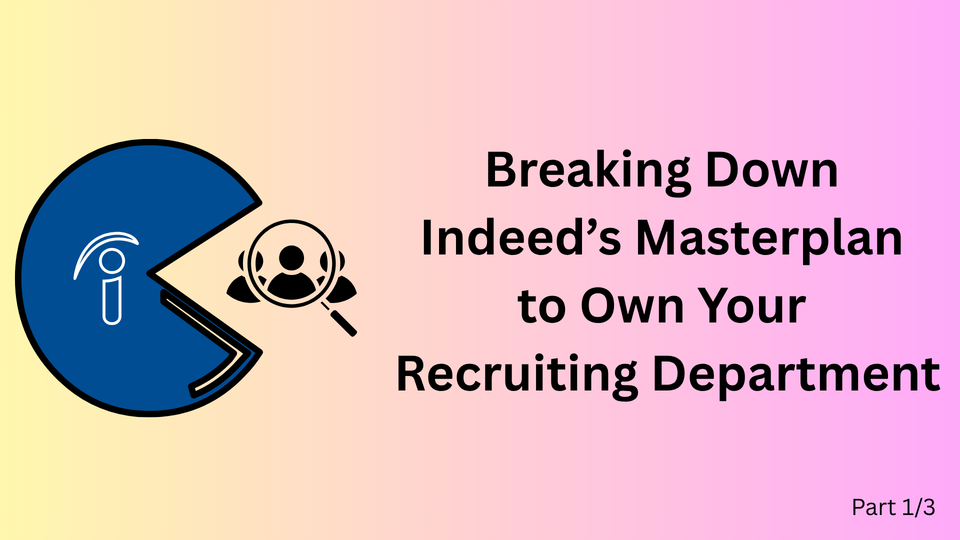
This is part 1 of 3 blog posts dedicated to Indeed’s master plan to own recruiting end-to-end.
In the first part of this blog post, I will review the new policies that Indeed announced in June 2025 and how history is repeating itself, revealing that this is a calculated step, part of a larger master plan.
Introduction
I have to admit, this blog post is a bit of a long shot, and for the most conservative of you, I highly recommend putting a tin foil hat before you join the journey. Yes, some of the things might sound a bit crazy, but they are also quite logical when you look into the developments in Indeed’s backyard over the past 10 years. For this specific post, I have delved into the details, gathering actual announcements and snapshots from annual reports.

My central hypothesis is that Indeed aims to FULLY take over the recruiting functions and departments of companies in three steps:
- Consistently cutting the middleman in recruitment marketing (job boards, agencies, programmatic)
- Building tools up and down the recruiting funnel to facilitate hiring (AI Matching, Screening, Interview tools, etc).
- Using disposition data to detect hiring needs based on past behavior and transactions, and to serve your next hire.
No, I don’t mean that they want to hire you on a pay-per-hire model; I mean that they would like to do it end-to-end.
Like, they will plug in your ATS and then from now on, everything is going to run mostly on autopilot:
“Here are the two new salespeople you need next quarter – they are pre-screened, pre-vetted and with a 95% chance of being hired based on past data”.
“We know that your top marketing manager, John, left for Company XYZ – here is the profile of Kyle from Company BYC that is ready to start tomorrow and will do the same work”.
“Kyle, an opening for a Marketing Manager has become open at Company BZC with a 10% salary increase – you are already preapproved and you start tomorrow”.
In the process of doing this, they will most likely change the way jobs are offered to job seekers, and we might see a future of 1984-style pre-approved job offers being served to you based on where you apply, where you were hired in the past, and how you performed in interviews, which itself comes with dire consequences.
But let’s take a few steps back and see how we got here.
Indeed’s Policy Change: No More Agency XML Feeds for ATS-Integrated Employers
Last week (June 22) Indeed announced a significant policy change, effective June 2025, that will prohibit agencies from requesting or maintaining single-source job feeds on behalf of US-based employers whose Applicant Tracking Systems (ATS) are already integrated with Indeed.
In plain terms, if an employer’s ATS already plugs into Indeed, agencies can’t push that employer’s jobs to Indeed via their feed anymore.
In the future, the only way agencies can manage such clients’ jobs on Indeed is through Indeed’s systems – specifically, via Indeed’s Job Update API.
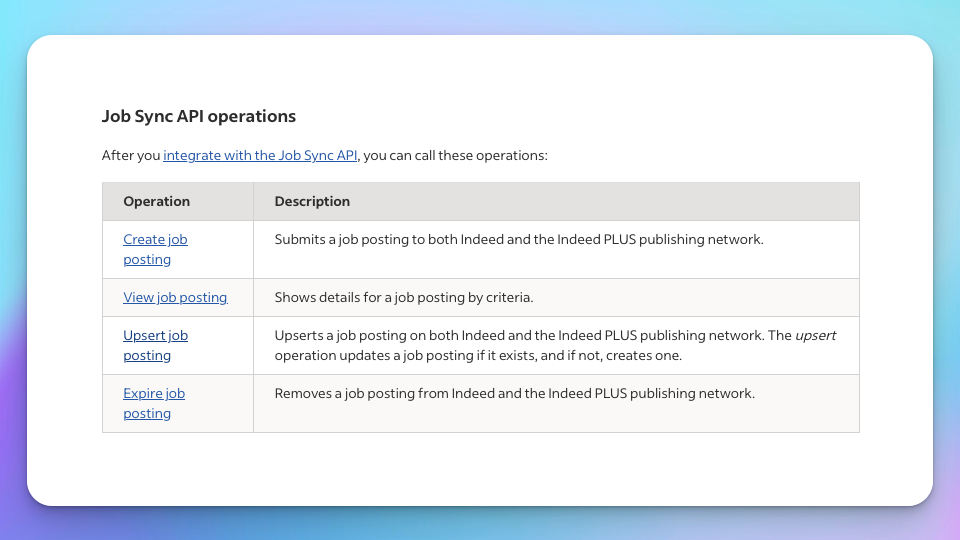
This change essentially forces an employer’s “source of truth” for job postings to be its own ATS. Indeed’s guidance directs agencies to “integrate with the Job Update API” to make any updates in partnership with the client’s ATS. In other words, agencies must use Indeed’s approved technical path rather than their traditional methods.
What does this change mean
If you read the part above carefully, you will surely ask yourself – well, they are not kicking agencies out, they are just asking them to use the APIs.
Now, there are some good reasons why people use feeds for these tasks – the ATS is an awful source of truth, because there is a discrepancy with how job advertising works, how Indeed’s algorithms work and how the ATS works.
Here is where agencies come in with the feeds and address some of the issues – adjusting job titles, refining descriptions, correcting awkward formatting, cloning jobs to create A/B tests, handling multiple locations, and tricking Indeed into accepting evergreen jobs by adjusting the posting date, among other tasks. The truth is that it is a lot easier to do this in an Excel sheet and then export it to XML rather than:
- Build an internal CRM to manage campaigns
- Store everything in a database
- Connect to the API
- Build webhooks to update
- Sync the API to your database and run the campaigns
However, agencies now need to integrate with Indeed’s API and manage campaigns through it.
Of course, agencies worry that they can no longer perform optimizations in advance of the job posting hitting the platform (budgets, tracking, tweaks, one-click apply, etc.). With this policy update, the agency will have to wait until after delivery to manage the job content and hope they can still make the necessary changes in time.
So, in essence, you need two integrations – one to manipulate jobs and one to manipulate campaigns. And let me tell you something – Indeed’s APIs are not a walk in the park. Integrating with an API also requires resources on both your end and the provider’s site. You need to get approved to use it and, as resources are always limited, you will guess who gets prioritized first.
The risk here is that small players will be left out, and just a few prominent names will have access. This new barrier-level approach helps Indeed get closer to employers and remove middlemen.
Now, objectively, I understand why Indeed also wants to stop this – they are forcing people into a standardized flow to prevent bright individuals from tricking the algorithms and cutting out wasted advertising spend (Jim explains this very well in his interview with the Chad n Cheese Podcast).
The five prominent names in the industry that we are all familiar with are relatively safe for now, as they continue to generate substantial revenue for Indeed.
But this is nothing new...
History is repeating itself.
It is time for a history lesson!
This is not the first time that Indeed has closed its platform to a recruitment marketing ecosystem vendor.
Historically, Indeed's business model was primarily based on a Pay-Per-Click (PPC) advertising system for sponsored job listings. Employers would set a daily budget, and charges were incurred each time a job seeker clicked on their sponsored job listing on the Indeed search results page.
This model provided visibility based on clicks, but did not guarantee the quality of applicants or the success of hires. Alongside paid listings, Indeed offered free job posting options and indexed jobs directly from company career sites or other job boards, providing free organic visibility. This dual approach enabled Indeed to build its extensive job database, which in turn drove SEO, resulting in a rapid growth of the user base and attracting even more customers.
This is what Indeed calls internally “SEO Flywheel” (not my term - their own).

Everyone was allowed to participate. It is not that long ago that job boards and aggregators could also sponsor jobs on Indeed. This is what Indeed was built on.
Over the decade, Indeed transformed from a job search aggregator with free listings and CPC ads into a more closed, full-service platform: it restricted free postings, made third parties pay or removed them completely, introduced hiring and assessment tools, experimented with pay-per-application pricing, and even attempted to monetize job seekers, eliminating all middlemen in between.
Here is the timeline of all the steps that led us to this point.
It started in 2017 when Indeed stopped accepting feeds from Job Boards
I had to dig hard to find some old evidence on this, but Smartjobboards still has a page that explains how job board owners could submit their feeds to Indeed, for free:
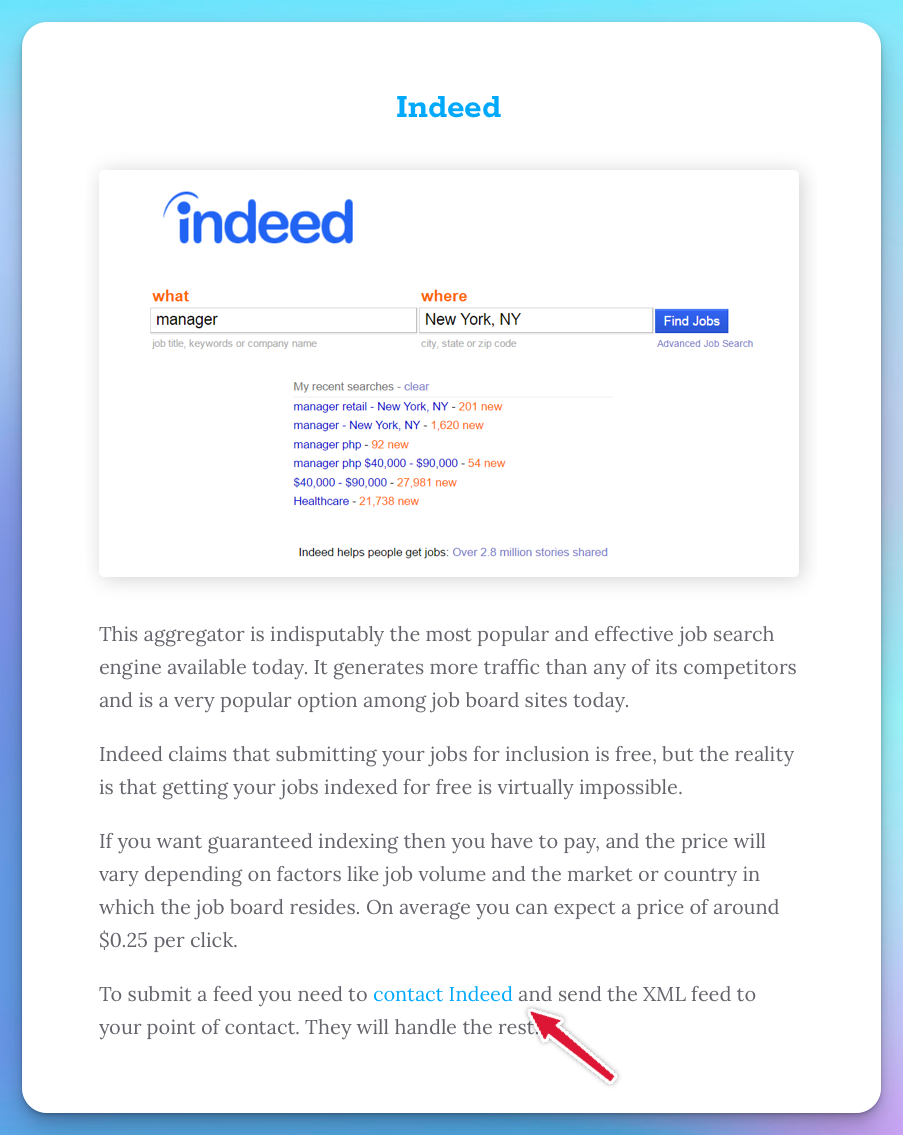
And just like that, in 2017, everything changed. Here is a screenshot from the Indeed policy doc:
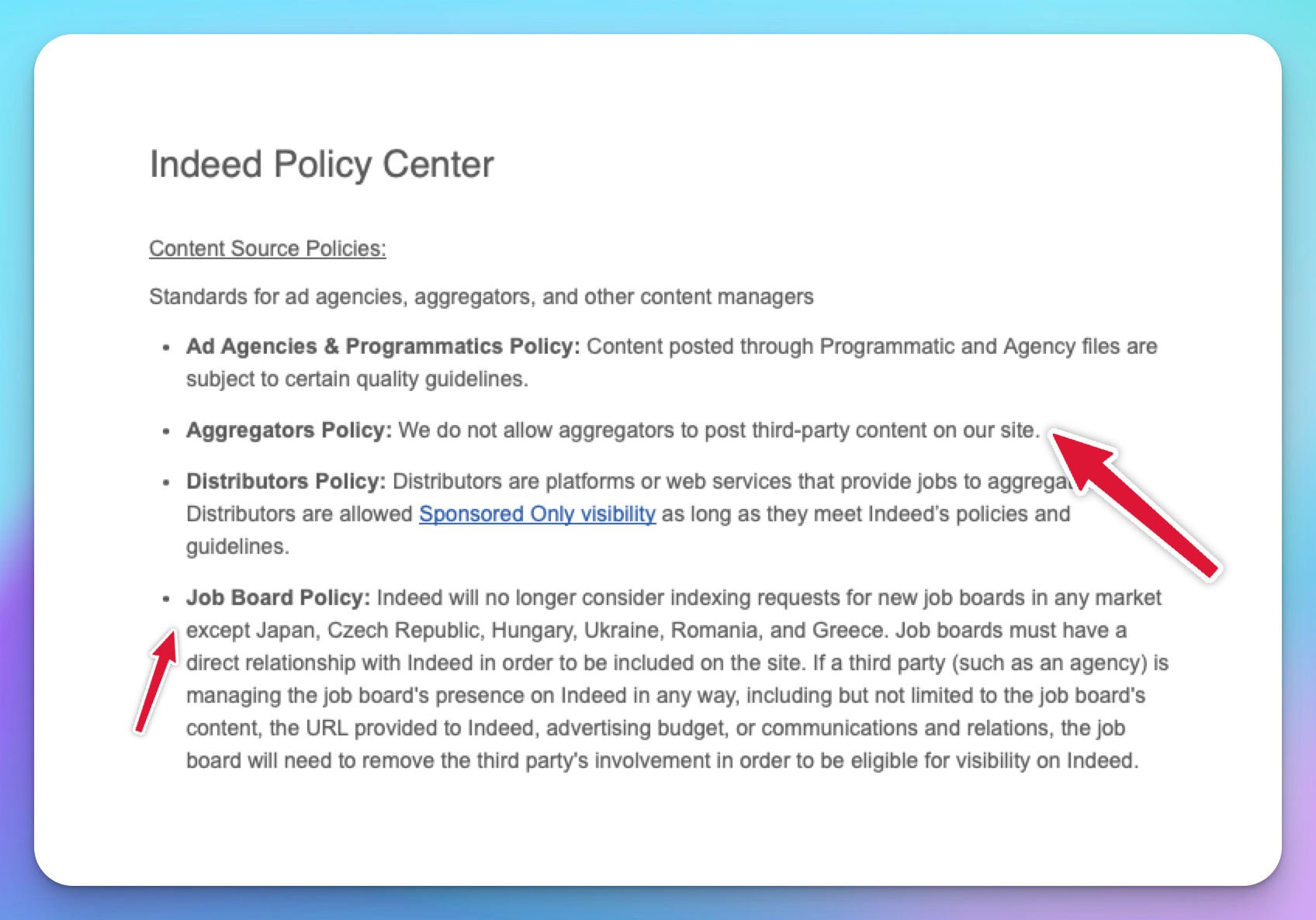
It took approximately two years for the policy to be fully implemented, but job boards were just the beginning.
You can guess or already know who was next in line.
Indeed goes after agencies.
Late 2018 and January 2019 marked Indeed’s most significant policy change – no more free Posts for agencies and boards. Indeed announced that it would remove all free job postings by recruiting firms, staffing agencies, and specific job boards that were left over after the 2017 cleanup, requiring them to pay for visibility. Direct employers could still post free listings, but their visibility would decrease over time without a sponsorship. This policy was expanded globally, with all recruitment agencies ceasing to receive organic visibility from May 2, 2024, across all markets except Japan.
This topic has garnered considerable attention in the industry and has been extensively covered by various media outlets. However, I recommend this podcast if you want to learn more.
But this was not the end.
Starting October 1, 2024, Indeed implemented a policy change where job listings directly posted on the platform by employers who already have jobs indexed through their Applicant Tracking Systems (ATS) will no longer receive free organic traffic. These direct posts will need to be sponsored to maintain visibility.
This change is a deliberate step in the master plan.
Now that we covered how Indeed spent the last decade in cutting out the core members of the hiring ecosystem (job board, aggregators, agencies), the very businesses that helped them grow, let's discuss why they are doing this.
Indeed has been trying to do end-to-end hiring already since 2015 (!).
Do you remember Indeed Prime?
In 2015, Indeed launched Indeed Prime , a specialty platform to match top tech talent with employers. Later in 2019, Indeed Prime rebranded as Seen, expanding its offerings to a broader range of tech roles and providing career-coaching perks. The product was eventually phased out, as Indeed refocused on its core platform.
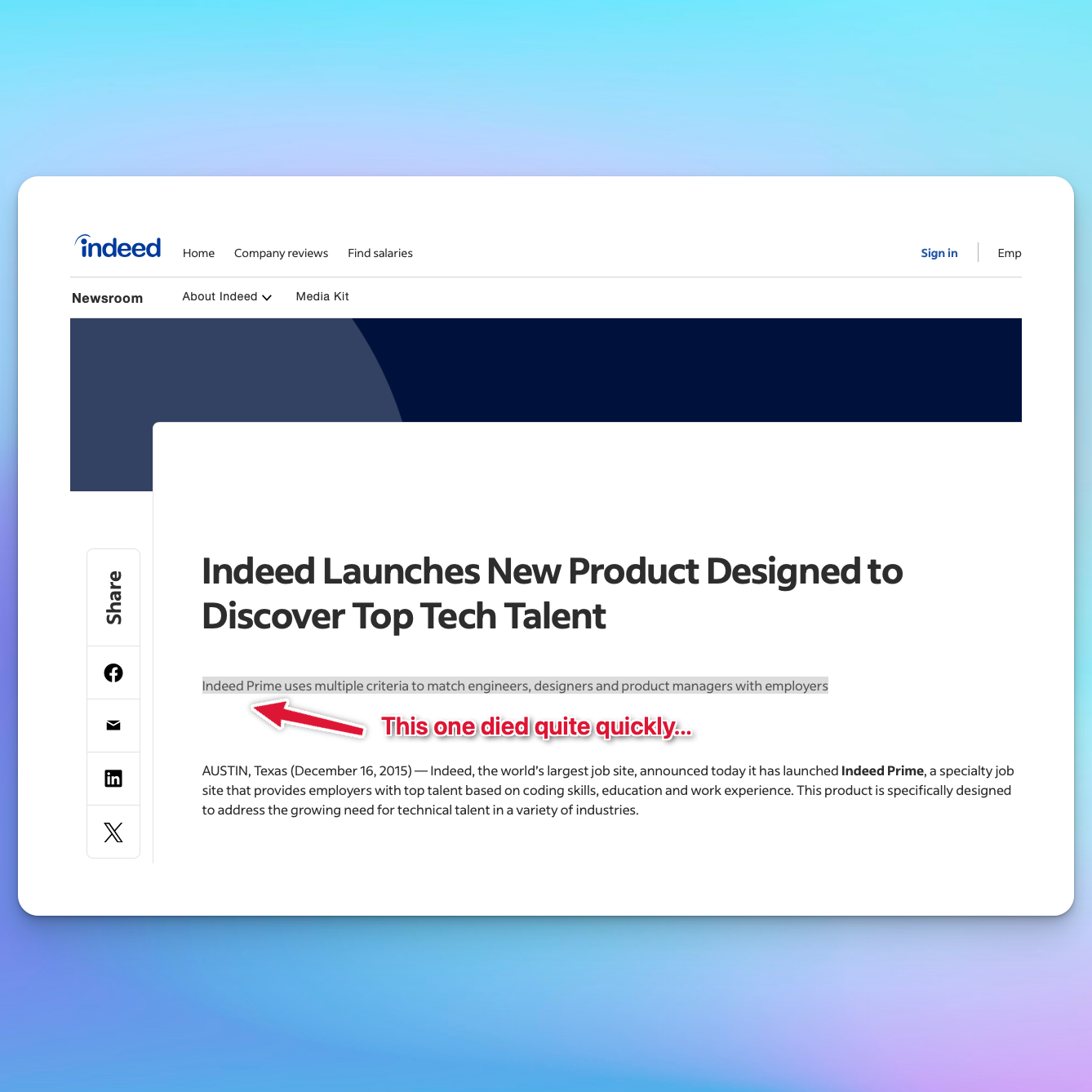
2016 saw the Introduction of Indeed Hire: an end-to-end recruiting service acting similarly to an agency. This service (again, later discontinued) was another signal for Indeed’s move into providing recruitment services for a percentage of hire salary, and their goal to get a higher take rate.
Indeed's self-proclaimed pivot to a "full-service recruiting agency" and its decision to stop offering free organic visibility to staffing and recruiting agencies is a final step in a strategic evolution. Indeed shifted from being a neutral platform that aggregates job postings from various sources, including recruitment agencies, to an active participant and direct competitor within the recruitment ecosystem.
The reason they are doing it is pretty straightforward - there is a 10x TAM to target in recruiting, rather than just job advertising.
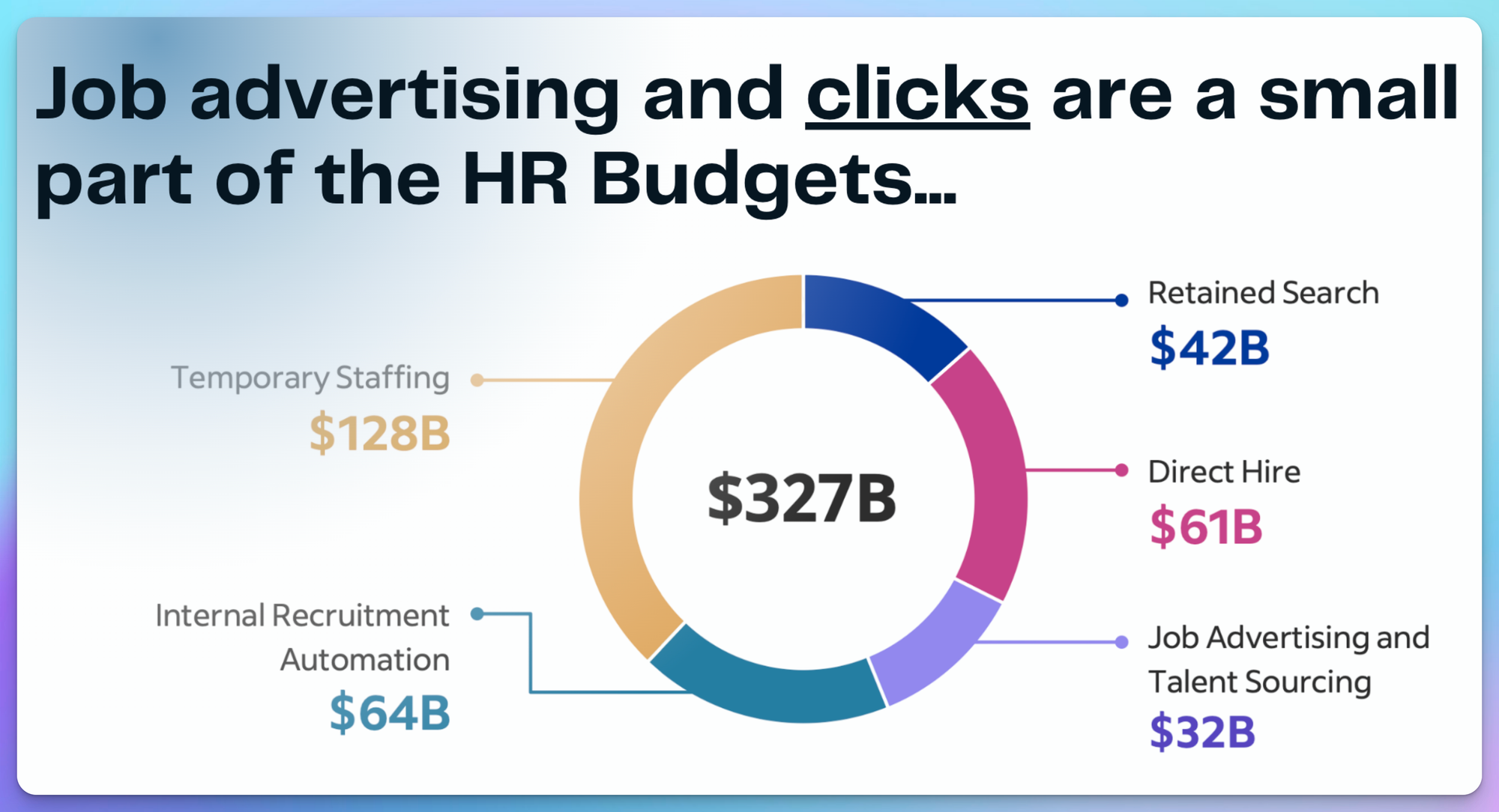
But, this is a topic for next week!
End of part 1 of 3
In the next blog post (part 2), I will discuss Indeed’s master plan in detail, including the parts they have executed so far and what remains on the list. In part 3, I will review what the future of recruiting will look like and what opportunities are still available for job boards (yes, it does not look so bad).
Here are also some additional posts you might find interesting for this topic on my blog:
Our Webinar on Indeed's AI Strategy
I hope you enjoyed this post. Please use the sign-up form below to get notified when the next blog post is published.
Additional sources to review:
Here are some of the quoted resources that I highly recommend reading
Jim Durbin (aka The Indeed’s Whisperer) evaluation of the policy change
Jim Durbin’s Interview with the Chad’n’Cheese Podcast
The Job Board Doctor’s industry analysis
Indeed Is Updating Its Job feed Policy by Joel Glick, the President of Buyer Avertising.